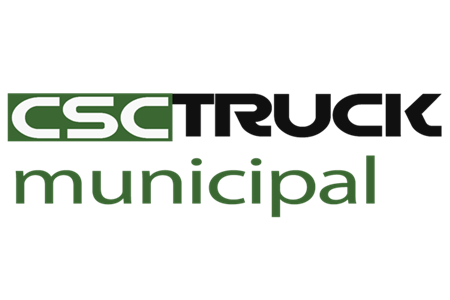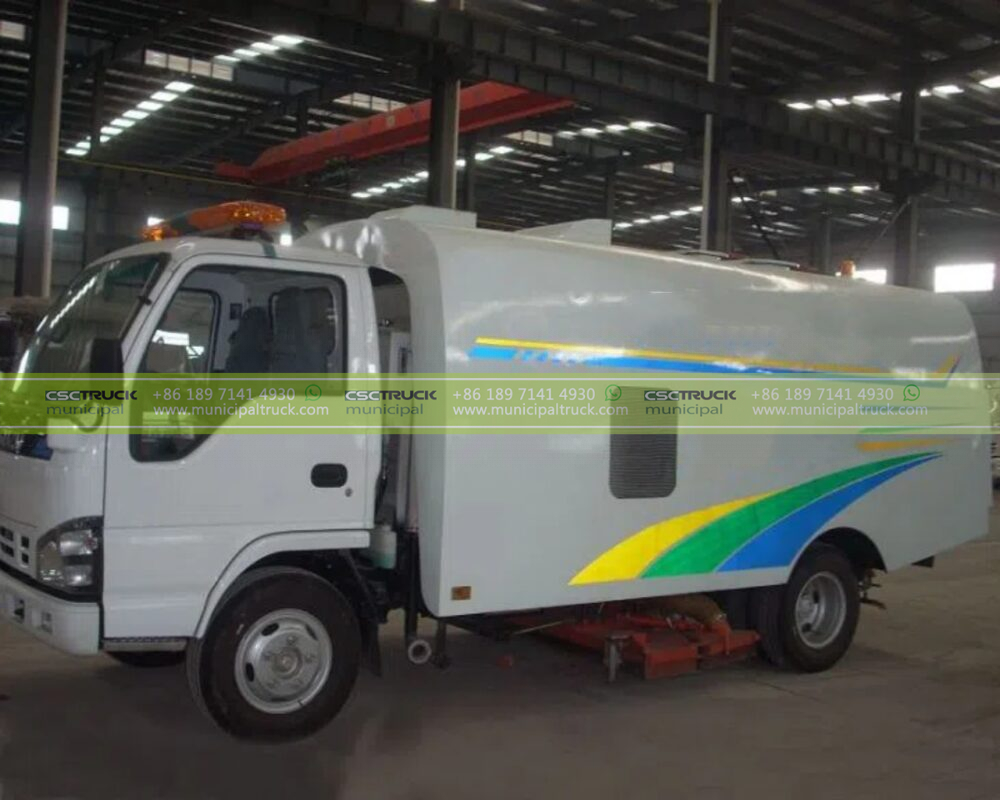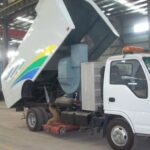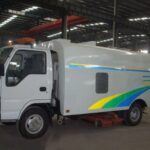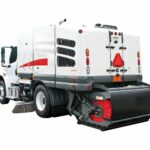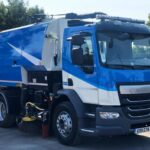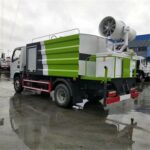As vast regions across the globe grapple with intensifying drought cycles, water scarcity transcends mere inconvenience, becoming a critical constraint on fundamental municipal operations essential for public health, safety, and urban livability. Among the essential services under scrutiny is street sweeping, traditionally reliant on significant volumes of precious water to suppress dust and capture debris. Enter the innovative waterless sweeper truck, a technological marvel rapidly evolving from niche solution to indispensable municipal asset. These advanced machines represent a paradigm shift, offering uncompromised cleaning performance while eliminating water consumption entirely, thereby conserving vital resources and ensuring operational resilience even under the harshest water restrictions. Their rise signifies a proactive adaptation to the realities of a changing climate, proving that clean streets and water conservation are not mutually exclusive goals.
The Escalating Drought Challenge and Municipal Imperatives
Drought conditions are no longer isolated events but persistent realities for many urban centers. Reservoirs dwindle, water tables fall, and stringent conservation measures become commonplace. Within this context, traditional municipal activities face intense pressure to adapt:
- Traditional Sweeper Reliance: Conventional mechanical broom and vacuum road sweeper trucks typically require hundreds, sometimes thousands, of gallons of water per operational shift. This water serves primarily for dust suppression – preventing fine particulate matter (PM10, PM2.5) kicked up by sweeping activities from becoming hazardous airborne pollution – and aiding debris capture into the hopper.
- The Unsustainable Equation: Using potable water, or even treated greywater, for large-scale street cleaning becomes increasingly untenable, and often outright prohibited, during severe drought stages. This forces municipalities into difficult choices: reduce sweeping frequency (compromising air quality and stormwater health), seek prohibitively expensive alternative water sources, or halt operations entirely.
- Compounding Problems: Reduced sweeping leads to accumulated debris, clogged storm drains (increasing flood risk when rain does arrive), degraded air quality from persistent dust, and unsightly streets impacting community pride and economic vitality. The waterless sweeper truck emerges as the critical solution to this complex equation.
Decoupling Cleaning Performance from Water Consumption
The core achievement of the waterless sweeper truck lies in its ability to deliver effective street cleaning without a single drop of water. This is not merely about turning off a spray bar; it requires fundamental re-engineering of the debris collection and dust control systems:
- Advanced Regenerative Air Systems: These systems are the cornerstone of waterless technology. Instead of relying on water to weigh down dust, they utilize powerful, multi-stage filtration systems capable of capturing ultra-fine particles directly from the airstream. A high-volume fan creates intense suction at the sweeper head.
- The Dust Containment Cycle: Contaminated air laden with dust and debris is drawn into the system. It passes through a series of progressively finer filters – often starting with a primary hopper separation, then cyclone pre-cleaners, and culminating in high-efficiency particulate air (HEPA) or similarly rated final filters. Crucially, a portion of the cleaned air exiting the filtration stages is recirculated (“regenerated”) back to the sweeper head. This clean air curtain acts as a barrier, helping to contain dust at the point of pickup before it can become airborne, effectively replacing the function of water spray.
- Optimized Mechanical Action: While air systems handle fine dust, mechanical brooms (or hybrid systems) remain crucial for dislodging heavier debris and caked-on material. Waterless designs often feature optimized brush configurations and materials, alongside precise adjustment capabilities, to maximize debris dislodgement while minimizing the dust cloud generated, working synergistically with the air system.
Subsection: Filtration – The Heart of Waterless Performance
The efficacy of a waterless sweeper truck hinges critically on its filtration system. This is where the battle against fine dust is won or lost:
- Multi-Stage Defense: Redundancy is key. Initial stages capture larger debris and the bulk of heavier dust. Subsequent stages, particularly the final fine particulate filters, are responsible for trapping the respirable particles most harmful to health and most visible as dust plumes.
- Filter Media Innovation: Utilizing advanced filter media capable of high dust-loading capacity while maintaining low airflow resistance is essential. Materials like nanofiber composites offer superior efficiency and longevity compared to traditional cellulose or synthetic fabrics.
- Cleaning Mechanisms: To maintain peak performance throughout a shift, automatic filter cleaning systems are vital. Common methods include reverse-pulse air jets or mechanical shakers that dislodge accumulated dust into the hopper without operator intervention.
- Sealing and Airflow Management: The entire air path must be meticulously sealed to prevent leaks that bypass the filters. Precise engineering ensures optimal airflow velocity and distribution across the filter surface for maximum capture efficiency.
Beyond Water Savings: Multifaceted Environmental and Health Benefits
While water conservation is the most immediate and visible benefit, the advantages of waterless sweeper trucks extend significantly further:
- Drastic Reduction in Dust Emissions: By capturing fine particles at the source with high-efficiency filtration, these trucks dramatically reduce particulate matter (PM) emissions compared to even water-assisted sweepers. This directly improves local air quality, a critical factor in urban areas with high asthma rates and during drought when natural dust sources may already be elevated.
- Protecting Stormwater Quality: Preventing debris accumulation means less litter, sediment, automotive fluids (oil, grease), heavy metals (from tire wear), and nutrients (like phosphorus from leaves) wash into storm drains during rain events. This protects rivers, lakes, and coastal ecosystems from pollution, aligning with broader watershed management goals.
- Reduced Carbon Footprint (Indirect): Eliminating the need to transport water for sweeping operations (tanker trucks delivering water to sweepers or sweepers traveling to fill points) reduces associated fuel consumption and greenhouse gas emissions. Furthermore, avoiding the energy costs of pumping, treating, and distributing water specifically for sweeping contributes to overall energy conservation.
- No Wastewater Runoff: Traditional sweepers generate dirty runoff water. Waterless technology completely eliminates this contaminated discharge, preventing potential soil and localized water pollution near dumping sites or during operation.
Operational Efficiency and Economic Advantages for Municipal Fleets
Adopting waterless sweeper trucks translates into tangible operational and financial benefits for municipalities and contractors:
- Uninterrupted Service During Restrictions: This is paramount. Waterless sweepers operate independently of water bans, ensuring consistent street cleaning schedules are maintained regardless of drought severity. This preserves air quality, stormwater function, and community cleanliness standards without exception.
- Reduced Operating Costs: Eliminating water costs (purchase, transport, treatment) provides direct savings. Further savings come from reduced wear and tear associated with water pumps, tanks, spray nozzles, and associated plumbing that are absent in waterless designs. While filter replacement is a cost, it is often offset by the savings elsewhere.
- Enhanced Productivity: Operators spend zero time filling water tanks. Routes can be planned purely based on cleaning needs and distance, not proximity to water sources. This allows for potentially longer operating ranges or more efficient route completion within a shift.
- Simplified Maintenance: Removing complex water systems (pumps, valves, tanks prone to corrosion and clogging) simplifies the mechanical upkeep of the sweeper. Maintenance focuses primarily on the filtration system, brooms, and the core sweeper mechanics.
- Extended Operational Windows: In freezing climates, water-based sweepers are often grounded due to the risk of ice formation in tanks and spray systems. Waterless sweepers face no such limitation, allowing for year-round operation, including critical early spring cleaning to remove winter sand and salt.
Deployment Considerations: Matching Technology to the Task
Successfully integrating waterless sweeper trucks requires thoughtful consideration of operational realities:
- Debris Load and Composition: Waterless technology excels at fine dust control. Routes with extremely heavy loads of large debris, wet leaves, or sticky mud may still pose challenges, though advanced models are continually improving in this area. Understanding typical debris profiles on target routes is crucial for selecting the right machine configuration.
- Surface Types: Performance can vary between asphalt, concrete, pavers, or gravel. Optimal brush types, suction head design, and airflows may need adjustment based on the predominant surfaces within a municipality.
- Operator Training: While operation is similar to conventional sweepers, maximizing the effectiveness of waterless systems requires specific training. Operators need to understand the filtration system status, optimal speed and broom settings for different conditions, and proper filter maintenance procedures to ensure sustained peak performance and longevity.
- Filter Management: Establishing efficient protocols for filter inspection, cleaning (on-board systems), and eventual replacement is essential. Factor in filter costs and disposal/recycling logistics in the total cost of ownership analysis.
The Future of Urban Cleanliness in a Water-Scarce World
The trajectory of waterless sweeper truck technology points towards even greater efficiency and intelligence:
- Enhanced Filtration Science: Continued advancements in filter media nanotechnology promise even higher capture efficiencies for the smallest particles, longer service life, and potentially reduced maintenance needs. Research into self-cleaning or regenerative filter surfaces is ongoing.
- Integration of Smart Systems: Expect wider adoption of telematics for real-time monitoring of filter status, airflows, engine performance, and location. This data enables predictive maintenance, optimizes routing, and provides verifiable proof of service completion and dust emission reduction for regulatory compliance.
- Electrification Synergy: The shift towards battery-electric sweeper trucks aligns perfectly with waterless technology. Electric powertrains offer zero tailpipe emissions, reduced noise, and lower operating costs. Combining electric power with waterless operation creates the ultimate sustainable urban cleaning platform, maximizing environmental benefits while minimizing resource consumption.
- Broader Applications: As technology matures and proves its reliability, waterless sweepers are expanding beyond municipal streets into industrial sites, ports, construction zones, and sensitive environmental areas where water use is restricted or dust control is paramount.
The quiet hum of a modern sweeper truck gliding down a city street at dawn, leaving behind visibly cleaner pavement without a trace of water spray, is a powerful symbol of adaptation and responsible resource stewardship. These sophisticated machines are no longer just cleaning our roads; they are safeguarding our water security, protecting our air, and ensuring the resilience of essential municipal services in an era defined by climate challenges. The evolution of the road sweeper truck into a waterless champion demonstrates that necessity truly is the mother of invention, paving the way for cleaner, drier, and more sustainable cities for generations to come. This sweeper truck, operating silently and efficiently, embodies the proactive approach required to navigate the complexities of drought, proving that effective urban management can flourish even when the skies offer little relief.
